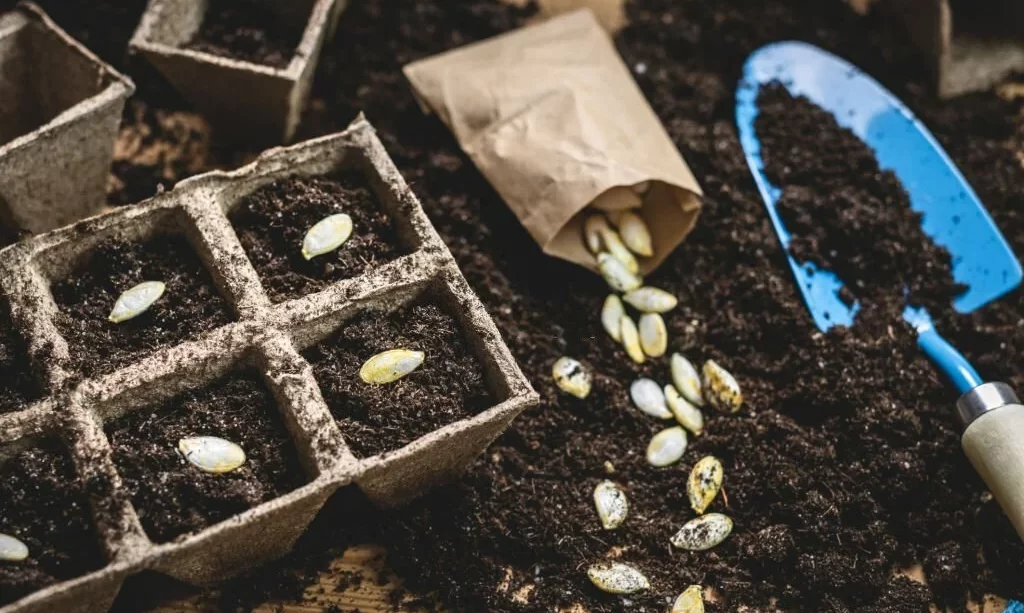As fall approaches in the picturesque state of Michigan, the prospect of growing pumpkins becomes a delightful endeavor for many. The anticipation of pumpkins adorning porches, transforming into jack-o’-lanterns, and providing the key ingredient for pies and other delectable dishes is a source of excitement. Yet, the journey begins with a fundamental question: “When is the best time to plant pumpkins in Michigan”? In this article, we will delve into the realm of pumpkin cultivation in the Great Lakes State, exploring the ideal timing for planting pumpkins. This knowledge is not only the key to a bountiful harvest but also the heart of a beloved seasonal tradition. So, let’s embark on this journey to discover the perfect moment to sow the seeds of pumpkins and celebrate their autumnal glory.
- Halloween Pumpkin – This standard Jack-O-Lantern pumpkin weighs in at a respectable 18-24 lbs and is an ideal carving and decorating pumpkin.
- Culinary Uses – The Jack-O-Lantern pumpkin is as tasty as it is beautiful! Makes great baked goods and delicious roasted pumpkin seeds.
- Grow Now or Later – Plant now or store for future growing seasons. Will remain viable for years if stored in a cool dry location. Each packet has instructions for saving seeds so you can perpetuate your harvest and share with others.
- The Info You Need to Grow – The pumpkin seeds for planting are packed in a beautiful paper packet with instructions for successful and easy growing and germination in your home garden. Each package also has instructions for saving seeds after harvest. Getting started is simple for both beginner and experienced gardeners.
- Small American Family-Owned Business – We are dedicated to providing fresh, high-quality seeds for planting now or storing. We offer only safe, non-hybrid, non-GMO heirloom seeds that are open-pollinated, untreated, and tested for optimal germination.
Pumpkin Varieties for Michigan
Michigan’s climate offers a hospitable environment for a variety of pumpkin types. The state’s diverse growing regions accommodate different pumpkin varieties, each with its unique characteristics and uses. One of the most popular choices for jack-o’-lanterns is the classic Jack O’Lantern pumpkin. For those who prefer pumpkins suitable for pies and other culinary delights, the Sugar Pie pumpkin is a top choice, known for its sweet, fine-textured flesh. The Connecticut Field pumpkin is another option that adapts well to Michigan’s climate, with its large size making it ideal for carving and decorating. Additionally, the Howden pumpkin is renowned for its dark orange color and strong stems, perfect for adorning your doorstep come Halloween. Understanding the available pumpkin varieties allows you to select the type that best suits your intentions, whether it’s spooky decorations or scrumptious pumpkin pies.
Michigan’s Climate
Michigan’s climate is characterized by a combination of factors that influence the timing of pumpkin planting. The state encompasses various hardiness zones, with the majority falling into zones 5 and 6. These zones have their unique frost dates, which play a significant role in determining when to plant pumpkins. In Michigan, the last spring frost date typically occurs between late April and early June, while the first fall frost usually arrives between late September and mid-October. These frost dates provide a window for your pumpkin planting schedule. Understanding the local climate is essential, as it directly impacts the growing season and the ideal timing for planting pumpkins. Michigan’s diverse climate conditions make it necessary to take local variations into account when planning your pumpkin garden.
Recommended Planting Times
The timing for planting pumpkins in Michigan depends on several factors, with the local climate and frost dates playing a central role. To achieve a successful pumpkin harvest, it’s typically recommended to plant pumpkin seeds directly outdoors after the last spring frost date, which in Michigan ranges from late April to early June. Planting pumpkins after the last frost ensures that the young plants won’t be damaged by freezing temperatures. If you’re eager to get a head start, you can also begin your pumpkin seeds indoors around 2-4 weeks before the last expected frost date. This approach allows you to nurture seedlings and transplant them into your garden once the risk of frost has passed. When transplanting, be sure to select a sunny spot with well-draining soil and sufficient space to accommodate the pumpkin vines. By following the recommended planting times and methods, you’ll set your pumpkin plants on the path to a fruitful harvest.
- 100% Natural & Organic Fertilizer Contains NO GMOs (Genetically Modified Organisms)
- Super Concentrated Slow Release – feeds plants and soil over time Treats up to 100 sq ft or 28 1-gallon plants up to 4 months.
- Improves Plant Growth Will not burn plants ( when used as directed )
- 6-2-3 Organic Fertilizer With 25% WOW Mycorrhizae plus Kelp & Humates For use in soil amending, transplanting, and established plants 100% Natural and Organic
- Contains Mycorrhizae for explosive root growth Contains WOW Mycorrhizae,At Least 85,000 Microbes Inside 2.2 lb Bag. Increases absorption of nutrients and water
Preparing the Soil and Site
Preparing the soil and selecting the right site are crucial steps for a successful pumpkin harvest in Michigan. Pumpkins thrive in well-drained soil that’s rich in organic matter. To enhance soil fertility, consider incorporating compost or well-rotted manure before planting. A soil pH level in the range of 6.0 to 6.8 is typically ideal for pumpkin growth. Choose a planting site that receives plenty of sunlight, as pumpkins love sun exposure and require at least 6-8 hours of direct sunlight daily. Ensure the site has good air circulation to minimize the risk of diseases, and consider planting pumpkins on mounds or raised beds to improve drainage. It’s also important to provide ample space between pumpkin plants, as they can be quite sprawling. By carefully preparing the soil and selecting an appropriate site, you’ll create the best conditions for your pumpkins to thrive.
Caring for Pumpkin Plants
Caring for pumpkin plants in Michigan involves several important practices to ensure a robust and fruitful crop. Pumpkins are heavy feeders, so they benefit from regular fertilization. Consider applying a balanced, all-purpose fertilizer according to the manufacturer’s instructions. When it comes to watering, pumpkins require consistent moisture, particularly during the growing season. It’s essential to keep the soil evenly moist, but not waterlogged. Applying a layer of mulch around the base of the plants can help retain soil moisture and deter weed growth. Be vigilant for pests and diseases that can affect pumpkin plants, and take appropriate measures to manage these issues. To encourage proper pollination, you may need to hand-pollinate if you notice a shortage of bees or other pollinators in your area. Regularly monitor your pumpkin plants for signs of stress or issues and address them promptly to support healthy growth and a productive harvest.
- STIMULATE & ACCELERATE: An acidic foliar fertilizer that feed through roots and leaves which contains a blend of plant growth stimulants and other nutrients designed to accelerate plant growth and improve yields
- MICRO-NUTRIENTS: Contains micro-nutrients and vitamins plants need
- HIGH CONCENTRATE: 1-2 oz per gallon of water; makes up to 32 gallons of fertilizer
- GUARANTEED ANALYSIS: 11% Nitrogen | 8% Phosphorus | 5% Potassium with .02% Boron .1% Iron .05% Manganese .05% Zinc
- MEASURE & POUR: Comes in an easy measure and pour bottle that allows the end-user to measure and pour a specific dosage by simply squeezing the bottle. See images for directions.
Conclusion
In conclusion, knowing when and how to plant pumpkins in Michigan is the key to enjoying a successful and rewarding harvest. By adhering to the recommended planting times based on local frost dates and understanding the unique climate of Michigan, you can make the most of the pumpkin-growing season. Preparing the soil, selecting the right planting site, and providing proper care, including watering, fertilization, and pest management, are essential for nurturing healthy pumpkin plants. Michigan’s diverse climate and rich soil offer a fantastic opportunity for cultivating pumpkins of various types, from carving pumpkins to those destined for your favorite fall recipes. Embrace the joy of pumpkin cultivation in Michigan and savor the delightful taste of homegrown pumpkins in the autumn months.






